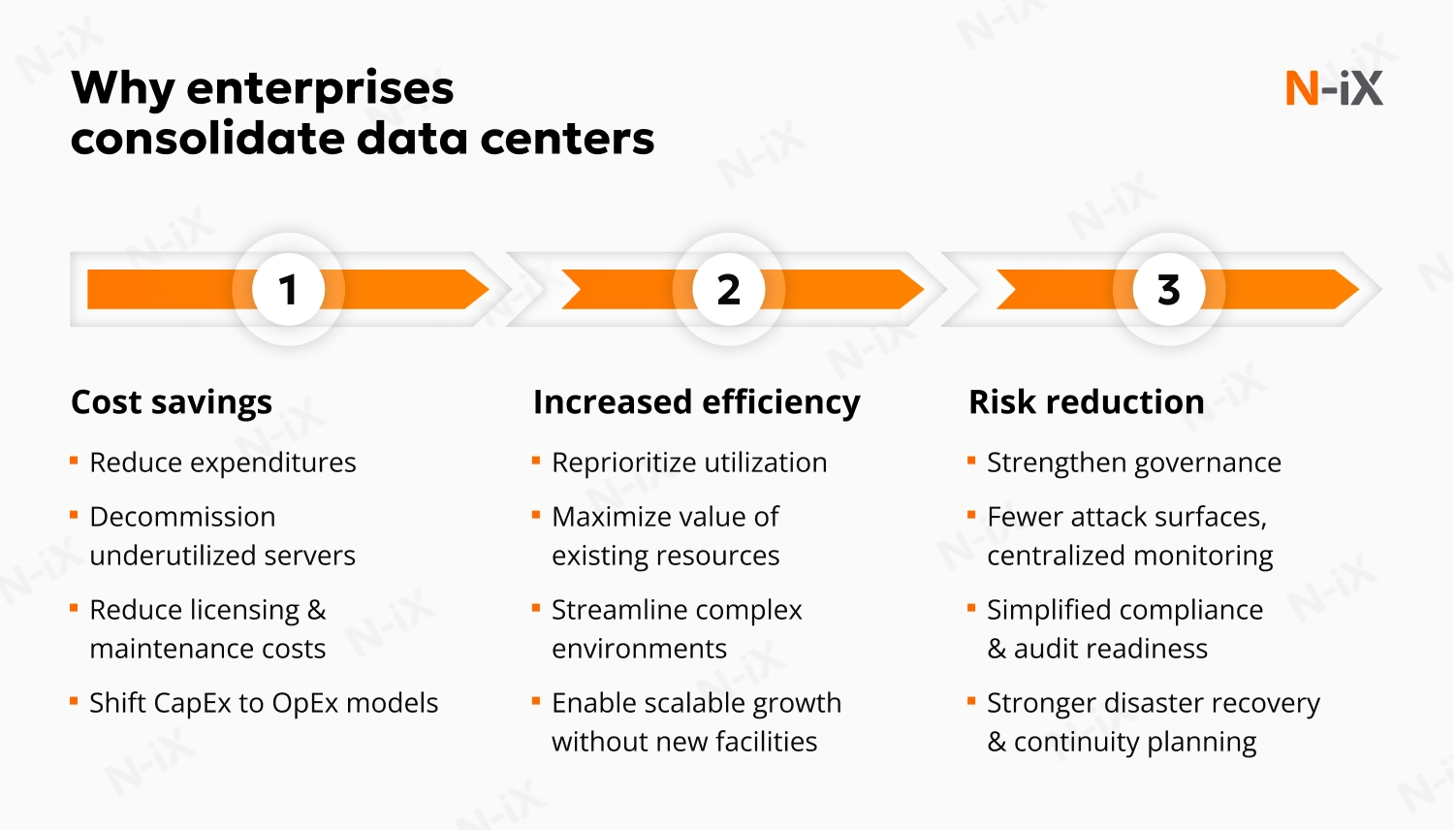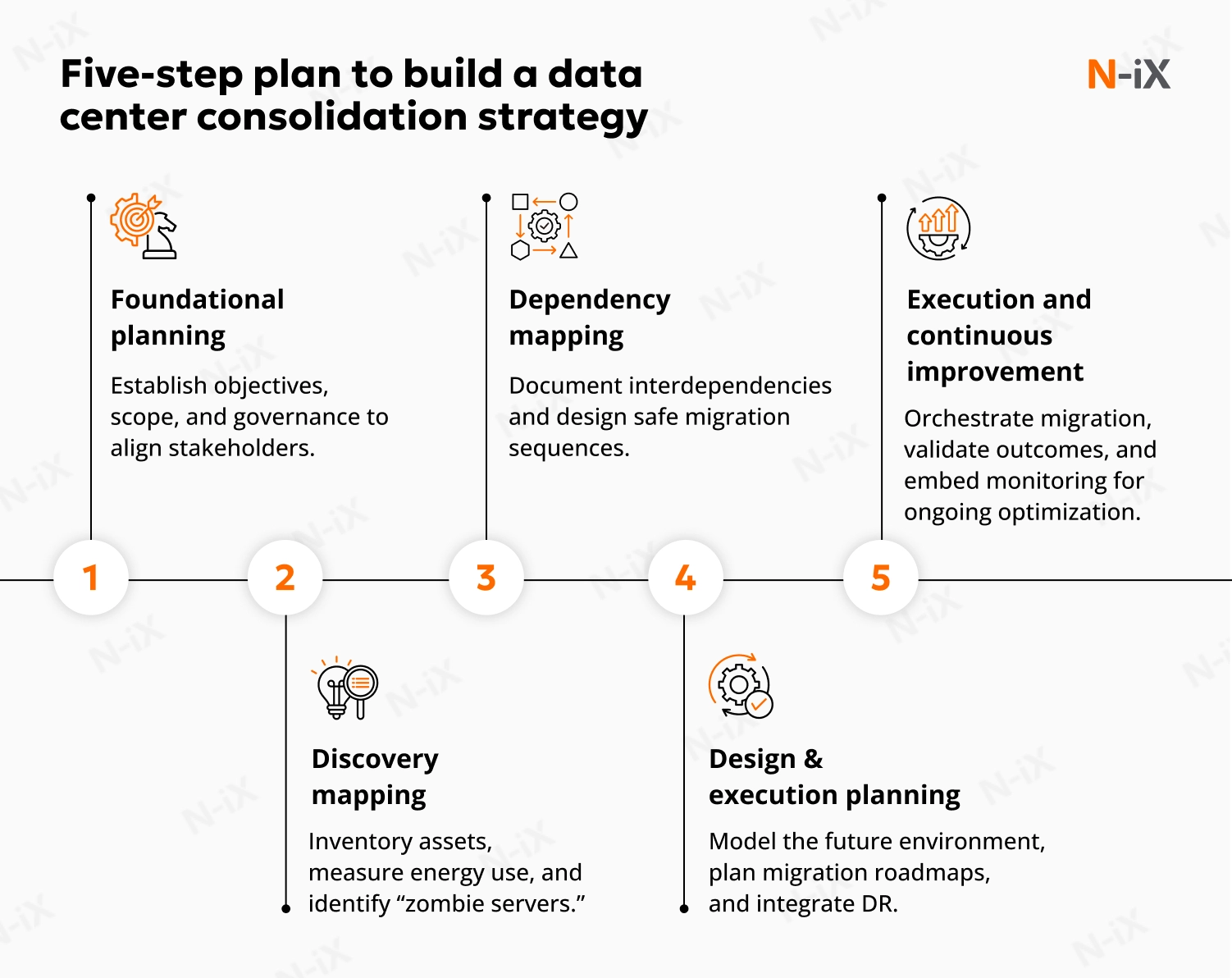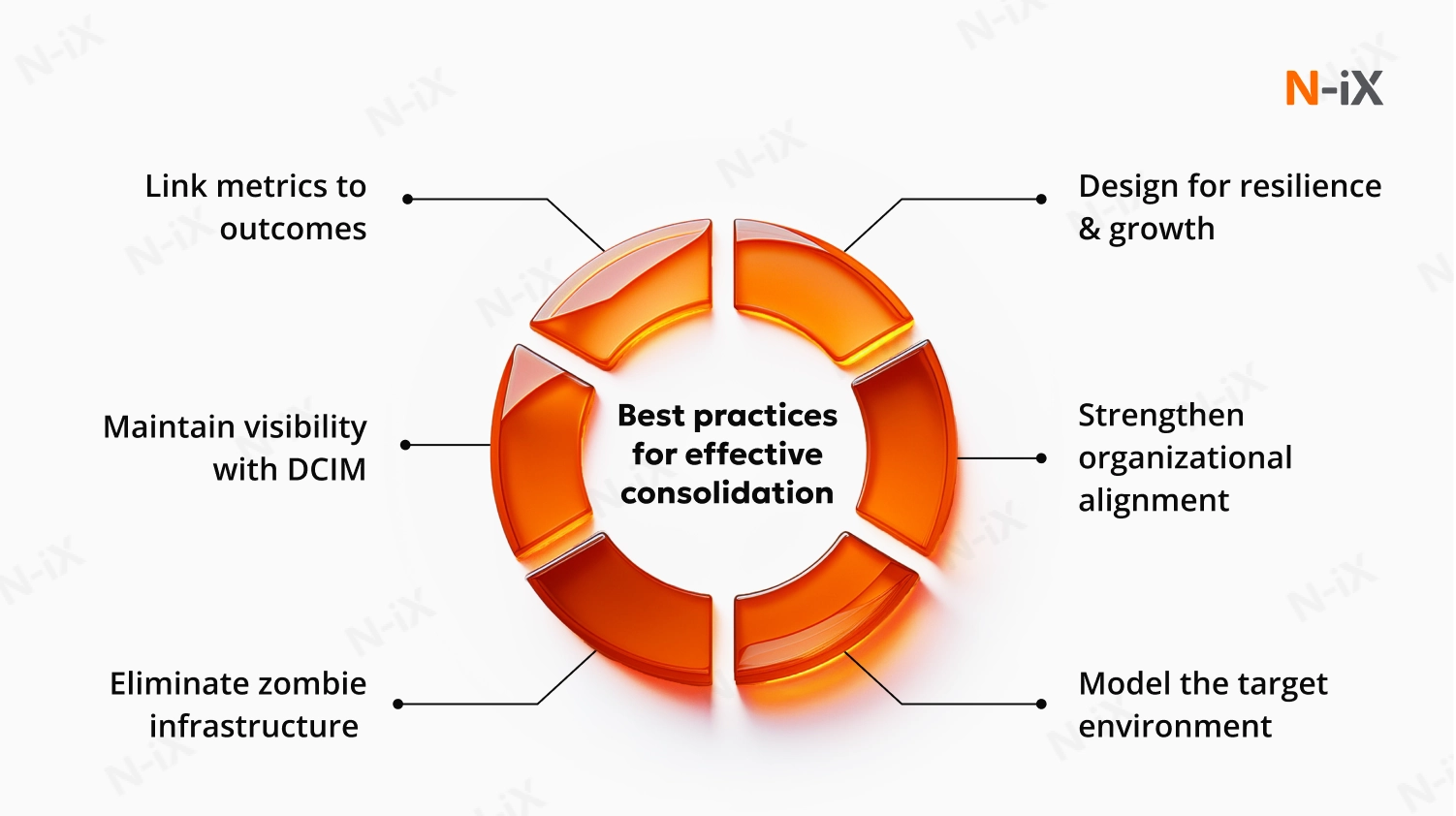Running multiple data centers may once have felt like a sign of stability, but for many enterprises, it has become a costly burden. Energy bills rise faster than budgets, compliances grow more complex, and IT teams spend more time maintaining aging infrastructure than enabling new business initiatives. And as organizations expand into cloud and AI, every fragmented data center becomes another barrier to agility.
A well-planned data center consolidation strategy addresses these challenges head-on. By reducing the number of facilities and streamlining infrastructure, enterprises can cut operating expenses, simplify compliance, and prepare for hybrid cloud and AI adoption. Consolidation is less about "shrinking IT" and more about building a foundation where your infrastructure supports business priorities instead of constraining them.
If you are weighing how to make data management more efficient, secure, and aligned with business goals, consolidation may be the most direct path forward.
What does a modern data center consolidation do for your business?
Consolidation almost always involves at least one data center migration, which requires moving data, applications, and infrastructure from one facility to another. The process becomes more complex when transitioning from an on-premises environment to a third-party provider. Organizations should establish a strategy that sets clear goals for productivity, redundancy, network connectivity, scalability, efficiency, security, compliance, and overall performance.
A data center consolidation strategy focuses on reducing the number of facilities and systems, streamlining infrastructure, and integrating data management. Unlike initiatives that seek to expand capacity, consolidation aims to create fewer, more centralized, and more efficient environments without changing the overall data volume.
Data center consolidation is not a single action. It can unfold across several dimensions depending on where inefficiencies exist. In practice, most strategies combine three forms of consolidation, each targeting a different layer of the IT environment.
- Physical consolidation is the most visible. It reduces the number of data center facilities, server rooms, or racks that must be maintained. The impact here is tangible: lower real estate costs, reduced energy consumption, and fewer maintenance contracts. Organizations simplify daily operations and improve reliability by concentrating resources into fewer, more efficient locations.
- Virtual consolidation addresses inefficiencies at the compute and storage layers. By virtualizing workloads, adopting containerization, or redistributing underutilized resources, enterprises can shrink the number of servers and storage systems in use.
- Operational consolidation takes place behind the scenes but delivers equally significant benefits. Streamlining contracts, renegotiating vendor relationships, and reducing the number of support structures can eliminate licensing duplication, lower administrative overhead, and simplify governance.
The actual scope of consolidation is broader than retiring hardware or shutting down facilities. It is about reducing redundancies, standardizing management, and creating a leaner operating model across all physical, virtual, and operational layers.
Why data center consolidation is important for data management
A data center consolidation strategy is a reductive program: the number of storage systems and facilities decreases, while management is streamlined. When executed with a clear plan, the result is lower cost, higher efficiency, and reduced risk.
1. Financial impact and cost reduction
Cost remains the most visible outcome. Consolidation cuts the operational burden of running dispersed facilities and maintaining duplicated hardware. Decommissioning underused or outdated servers removes recurring maintenance expense and curbs licensing and support overhead. Energy consumption drops as workloads are placed on fewer, better-utilized systems. Eliminating duplicate capacity avoids unnecessary spending on hardware and staffing, and shifting parts of the estate to third-party providers can replace large upfront capital expenditure with usage-based operating expense.
2. Operational efficiency
Operational efficiency follows. Combining fragmented environments simplifies how infrastructure is monitored, patched, and scaled. Teams spend less time sustaining redundant systems and more time optimizing performance. Central oversight improves availability and response times, and a smaller footprint reduces the complexity that often slows cloud and edge adoption. Where appropriate, moving workloads into provider facilities adds access to managed services, extending internal capacity without expanding headcount.
3. Risk reduction
Security and compliance improve when the attack surface is smaller and control is centralized. Fewer systems and locations make applying consistent monitoring, patching, and access controls easier and responding quickly to suspicious activity. Dedicated facilities typically add robust physical protections, perimeter controls, surveillance, and access management. Standardizing on a single security and compliance policy across consolidated environments helps meet frameworks more predictably. Location choices also matter: placing assets in less vulnerable regions or facilities engineered for extreme weather reduces geographic risk.
4. Scalability and disaster recovery
Scalability and recovery strengthen as the environment becomes more coherent. Capacity can be increased or reduced without building new sites, minimizing disruption and capital outlay. Disaster recovery design is more straightforward and reliable when data and workloads are centralized; replication and backups can be standardized, and recovery time is typically shorter during unplanned events.
Key strategic pillars of the data center consolidation strategy
The effectiveness of a consolidation project depends on well-defined objectives that guide decision-making and validate outcomes. While each organization's priorities vary, the goals typically align around three main pillars: financial optimization, operational efficiency, and risk reduction.

Goal: Cost savings and financial optimization
For most organizations, financial benefits are the strongest driver of consolidation. The ability to shrink infrastructure and operate fewer facilities creates immediate and measurable results.
- If your goal is to lower operating expenses, consolidation helps by decommissioning underutilized servers, reducing licensing requirements, and eliminating redundant maintenance contracts.
- When energy efficiency is a priority, streamlining workloads across fewer, more efficient systems cuts electricity and cooling demand.
- Whether you need more financial flexibility, moving from capital-intensive ownership models (CapEx) to pay-as-you-go services (OpEx) can free up budgets. Leveraging colocation or cloud services enables scaling without overprovisioning hardware that may sit idle.
Goal: Increased efficiency and productivity
A data center consolidation strategy also improves the effectiveness of IT assets in supporting operations. It ensures infrastructure is used to its full potential and simplifies environments that have grown too complex.
- If your objective is to maximize the value of existing resources, centralization makes better use of hardware, enhances system performance, and improves overall uptime.
- When reducing complexity is essential, consolidating multiple environments into a smaller, centralized footprint helps IT teams streamline operations, which is especially critical when adopting cloud or edge solutions.
- Whether your organization prepares for growth, a consolidated environment provides scalable capacity. New workloads and data volumes can be absorbed without requiring new facilities or disruptive infrastructure upgrades.
Goal: Risk reduction, security, and compliance
By bringing infrastructure under tighter control, consolidation reduces vulnerabilities and improves governance.
- If strengthening security is a priority, fewer facilities and servers mean fewer entry points for malicious activity. Centralized monitoring and standardized controls enhance detection and response to threats.
- When compliance requirements are complex, a consolidated environment makes it easier to apply consistent policies across the organization. Centralized data governance simplifies audits and helps maintain adherence to frameworks.
- Whether disaster recovery is your focus, centralizing assets allows simpler replication, backup, and failover processes. Recovery times are shorter, and continuity planning becomes more reliable.
The choice to consolidate is often clear; the challenge is execution. A step-by-step data center consolidation plan is needed to sequence migrations, measure impact, and control risk.
Read about how to tackle top data center migration challenges
How to build a data center consolidation strategy
Data consolidation requires a structured methodology. At N-iX, we treat data center consolidation as a lifecycle program that touches strategy, design, execution, and operations. It is a staged transformation in which each phase sets the conditions for the next.

Step 1: Foundational planning
The consolidation journey begins with strategy. This phase is about more than setting up a data center consolidation project plan; it establishes the rationale, scope, and governance structures defining the entire effort. At the following stage, we work with stakeholders to translate broad expectations of cost savings, resilience, compliance, or scalability into precise objectives with measurable success criteria. We also define the scope of consolidation, determining whether it involves merging multiple enterprise facilities into one, rationalizing satellite environments, or integrating cloud and colocation into the mix.
Equally important, we align the organization around these objectives. Data center consolidation affects financial teams, compliance functions, and business units as much as IT operations. Therefore, we establish governance committees and change-management frameworks that provide executive sponsorship, coordinate cross-functional decisions, and build stakeholder confidence. Without this alignment, even the most carefully designed technical plan can falter in execution.
Step 2: Discovery mapping
We approach discovery mapping as the critical fact-finding mission that sets the foundation for every consolidation project. Our team goes beyond a simple asset count: we catalogue all physical servers, storage systems, networking equipment, and software-defined resources such as virtual machines and hypervisors. Importantly, we trace which business services and departments depend on these assets.
For example, a simple HR platform may rely on legacy databases, authentication services, and third-party APIs. If these dependencies are not identified, migrating the platform could cause cascading failures. Mapping these relationships allows architects to plan safe transitions and set migration sequences that minimize business disruption.
We also establish a precise baseline for energy consumption and efficiency. Using outlet-metered PDUs and advanced monitoring tools, we measure power draw at the device level, separating workloads requiring high capacity from those that can be consolidated with minimal impact. In many engagements, we uncover "zombie servers" or redundant platforms consuming electricity, rack space, and licensing costs without delivering value. Identifying and decommissioning them reveals immediate savings and simplifies the migration path.
Finally, we define the physical parameters of the future environment. Providing data center consolidation services, we analyze how many facilities are genuinely needed, where they should be located, and what electrical and connectivity infrastructure they require.
Step 3: Dependency mapping
While discovery shows what exists, dependency mapping reveals how it all connects. At N-iX, we document the relationships between workloads, applications, databases, and infrastructure. For instance, business platforms often depend on authentication servers, legacy databases, or third-party integrations that are not obvious at first glance. Mapping these interconnections allows us to design migration sequences that protect business continuity.
We also analyze historical outage data to uncover fragile dependencies and hidden risks. This practice often highlights weak links that configuration charts alone cannot capture. At the same time, we assess opportunities for virtualization, identifying where workloads can be redistributed or multiple virtual machines consolidated to reduce overhead and improve efficiency. These insights help clients minimize disruption and capture additional performance gains as part of the transition.
The output of dependency mapping is a tailored transition blueprint. It specifies which workloads can migrate together, which require isolation or redesign, and which must be sequenced with extra care.
Step 4: Design and execution planning
With the baseline established, the next task is to design the future-state environment and plan the transition. This phase transforms analysis into architecture. We model the consolidated environment in detail, leveraging Data Center Infrastructure Management (DCIM) platforms to simulate rack layouts, network flows, and power requirements. Automated capacity planning ensures the new environment is efficient and resilient, often unlocking significant utilization gains without additional capital investment.
But design is only half the story. Execution planning requires careful sequencing of workloads, explicit risk assessments, and integration of disaster recovery measures. Migration roadmaps are drawn up as timelines and living risk-management instruments: they specify rollback scenarios, downtime thresholds, and interdependency constraints. At the same time, we evaluate whether specific workloads are better suited for cloud migration or hybrid deployment.
To see consolidation and migration working together in practice, consider our work with a US healthcare provider. We migrated its EMR and operational data from on-premises systems to Google Cloud (GCP) using ETL pipelines built with Airflow, DBT, and Terraform, achieving streamlined operations and cost optimizations across data workflows. This case demonstrates how consolidation projects blend modernization, migration, and infrastructure realignment.
Step 5: Execution and continuous improvement
The final phase turns plans into outcomes. Execution begins with migration, supported by precise work orders and orchestration tools that translate design specifications into operational instructions. Testing and validation are woven through rehearsals that surface hidden issues, and later through stress testing of the consolidated environment to confirm stability, compliance, and resilience.
Yet execution does not end with cutover. Stabilization and continuous improvement are critical to protecting and extending the value of consolidation. We embed monitoring frameworks that track costs, utilization, performance, and security posture in real time. Power Usage Effectiveness (PUE) and other efficiency metrics are measured continuously to validate that the intended savings are materializing. Compliance dashboards provide visibility into regulatory alignment, while structured improvement cycles drawing on ITIL principles incorporate lessons learned into ongoing operations.
Over time, our data center consolidation approach is not a one-off event but a living transformation. The new environment evolves as business needs change, regulatory standards tighten, or emerging technologies reshape demand.
Best practices for every data center consolidation strategy
Numerous best practices can increase the success rate of data center consolidation strategy. The most important are those that optimize the technical environment and reduce organizational and financial risks:

- Linking metrics to business outcomes: We ensure that efficiency gains are not reported in isolation but tied directly to reduced OpEx, improved uptime, and measurable ESG progress.
- Maintaining visibility through DCIM and monitoring: Our experts deploy advanced monitoring and DCIM tools to help enterprises have a real-time, accurate view of capacity, utilization, and compliance across the consolidated estate.
- Identifying and eliminating zombie infrastructure: As many as 30% of servers in enterprise data centers are "zombies", machines still consuming power and maintenance budgets while performing no practical work. In every engagement, N-iX uncovers "ghost" servers consuming power and cooling without delivering value. Decommissioning these idle assets quickly reduces costs and frees up space for workloads.
- Modeling the target environment virtually: Before the first rack is touched, our teams build a virtual model of the consolidated environment. Digital buildout uncovers design conflicts early, optimizes cabling and layout, and gives executives and operations staff a visual roadmap.
- Strengthening organizational alignment: The technology is rarely the most challenging part; people are. We integrate organizational change management into every consolidation, aligning executives on priorities, preparing staff through training, and communicating changes clearly to reduce resistance.
- Designing for disaster recovery and future growth: Consolidation should never mean creating a single point of failure. We help clients pair data centers or build hybrid DR strategies. At the same time, we design with scalability in mind; the new environment supports cloud adoption and future workload demands.
To see these principles in action, consider how N-iX partnered with a leading audio streaming platform. That client consolidated and migrated its infrastructure, refactored workloads, and architected resilience across multiple environments. This case signals that successful consolidation demands execution discipline, governance, and deep technical insight.
The data center consolidation best practices are not abstract recommendations. They deliver precise results: lower operating costs by retiring unused infrastructure, higher efficiency through automation and DCIM monitoring, stronger security from central oversight, and resilience by embedding disaster recovery into the target design. Just as importantly, it lays the groundwork for modernization and AI initiatives.
However, knowing the practices and executing them are very different challenges. Many organizations later discovered that what looked like a straightforward consolidation involved hidden interdependencies, regulatory pitfalls, or resistance across business units. That raises a critical question: do you want to manage one of the most complex, high-stakes IT transformations alone or with a partner who has already navigated it many times before? A partner brings proven methods, cross-industry knowledge, and the ability to anticipate risks.
N-iX is here to combine infrastructure engineering expertise with structured change management to help enterprises plan, execute, and optimize their consolidation strategies. Our focus is on outcomes: reducing risk, improving efficiency, and building an environment that scales with business priorities.
Have a question?
Speak to an expert





